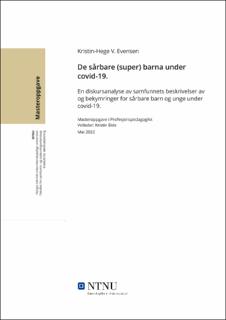| dc.contributor.advisor | Eide, Kristin | |
| dc.contributor.author | Evensen, V. Kristin-Hege | |
| dc.date.accessioned | 2022-08-06T17:19:50Z | |
| dc.date.available | 2022-08-06T17:19:50Z | |
| dc.date.issued | 2022 | |
| dc.identifier | no.ntnu:inspera:112400045:30875834 | |
| dc.identifier.uri | https://hdl.handle.net/11250/3010477 | |
| dc.description.abstract | Kjært barn har mange navn sies det. Usynlige barn, utsatte barn, sårbare barn er noen av mange ulike begrep som brukes om barn og unge som vokser opp under utsatte levevilkår. Den daværende statsministeren Erna Solberg hadde en klar tale i mars 2020 når covid-19 pandemien sto på som verst. «I dag kommer regjeringen med de sterkeste og mest inngripende tiltakene vi har hatt i Norge i fredstid» (Solberg, 2020). Denne masteroppgaven er skrevet ut fra en interesse om nettopp denne elevgruppen. Dette dannet bakgrunnen for problemstillingen «Hvilke bekymringer for og beskrivelser av sårbare barn og unge ble løftet frem under covid-19 pandemien?»
For å kunne undersøke dette har formålet vært å få innblikk i hvilke beskrivelser, bekymringer og til dels konsekvenser som ble løftet frem rundt sårbare barn når fraværet av en fysisk skolehverdag ble en realitet. Datamaterialet består av syv tekster som er publisert i media i løpet av en tidsperiode i 2020 og 2021. Gjennom et sosialkonstruktivistisk utgangspunkt, bidrar jeg til å kaste lys over hvilke diskurser man brukte i omtalelsen av sårbare barn og unge, og hvilke implikasjoner som kan oppstå ved å bruke et bestemt språkbruk rundt en bestemt elevgruppe.
Gjennom å ta i bruk diskursanalyse, med fokus på Fairclough (2008) sin tredeling diskurs har effekt på, i kombinasjon med Biesta (2010) og Imsen (2016) sin teori om skolens funksjon, har jeg identifisert diskursene som oppsto rundt sårbare barn og unge under covid-19 pandemien. Jeg har hovedsakelig identifisert to ulike diskurser som oppsto i samtalen rundt sårbare barn og unge. Disse ble identifisert som den psykososiale diskursen; en diskurs med fokus på sårbare barn og unges psykiske og sosiale forhold. Det som er fremtredende her er bekymringen rundt trygge voksne og barn og unge som lever i hjemmeforhold som kan være skadende for den enkelte. Den andre diskursen ble identifisert som den faglige diskursen; denne diskursen tar for seg samtalen rundt «kunnskapshullet» man var bekymret sårbare barn og unge var ofre for, og mangelen på den fysiske tilstedeværelsen av lærere. Videre drøfter jeg hvordan de ulike diskursene både kan ha positive og negative innvirkninger på sårbare barn og unges liv. Det finnes ulike måter å møte sårbare barn og unge på. Jeg har med analysen og drøftingen som bakteppe, sett det i sammenheng med pedagogisk nærvær som en rolle læreren burde innta, i møtet med denne elevgruppen. | |
| dc.description.abstract | A beloved child has many names, it is said. Invisible children, vulnerable children, exposed children are some of the many different terms used about children and young people who grow up under vulnerable living conditions. The former Prime Minister Erna Solberg had a clear speech in March 2020, when the covid-19 pandemic was at its worst. «Today the government has come up with the strongest and most intrusive measures we have had in Norway during the peacetime» (Solberg, 2020). This master´s thesis is base don an interest regarding this particular group of students. This formed the background for the issue «What concerns and descriptions of vulnerable children and young people were raised during the covid-19 pandemic?»
In order to be able to investigate this, the purpose has been to gain insight into the descriptions, concerns and to some extent consequences that were raised around vulnerable children when the absence of a physical school day became a reality. The data material consist of seven texts that have been published in the media over a period of time. Through a social constructivist starting point, I help to shed a light on what discourses were used in the discussion of vulnerable children and young people, and what implications can arise from using a specific language around a specific group of students.
By using discourse analysis, with a focus on Fairclough´s (2008) three areas discourse helps to construct, in combination with Biesta´s (2010) and Imsen´s (2016) theory of the school´s functions, I have identifies the discourse that arose around vulnerable children and young people, during the covid-19 pandemic. Through analysis and discussion of the data material, I have discovered mainly two different discourses. These were identifies as the psychosocial discourse; a discourse focusing on vulnerable children and young people´s mental and social conditions. What is prominent here is the concern around safe adults and children and young people living in home conditions that can be harmful to the individual. The second discourse was identifies as the professional discourse; this discourse addresses the conversation around the “knowledge gap” one was concerned about vulnerable children and young people being victims of, and the lack of the physical presence of teachers. Furthermore, I discuss how the different discourses can have both positive and negative impacts on the lives of vulnerable children and young people. there are different ways to meet vulnerable children and young people. With the analysis and discussion as a backdrop, I have seen it in context of pedagogical presence, as a role the teacher should take, in the meeting with this student group. | |
| dc.language | nob | |
| dc.publisher | NTNU | |
| dc.title | De sårbare (super) barna under covid-19. | |
| dc.type | Master thesis | |
